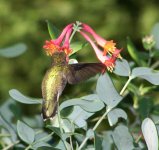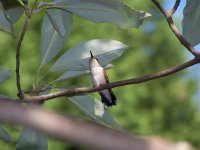Hello all,
I'm a novice at birding and at BirdForum. I imagine the bird pictured is a ruby-throated hummingbird, as I believe they are the only ones who regularly visit northern Virginia, USA. I wonder, though, if it is a female or an immature male. It was spotted taking advantage of a honeysuckle vine in mid-September.
Thanks,
Julie
I'm a novice at birding and at BirdForum. I imagine the bird pictured is a ruby-throated hummingbird, as I believe they are the only ones who regularly visit northern Virginia, USA. I wonder, though, if it is a female or an immature male. It was spotted taking advantage of a honeysuckle vine in mid-September.
Thanks,
Julie






